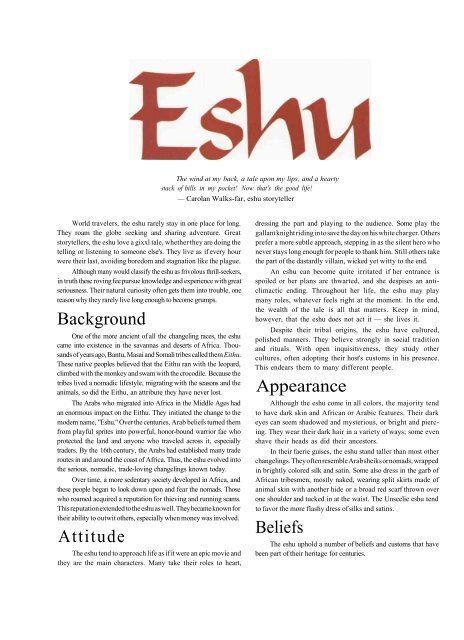Changeling - Players Guide.pdf
Changeling - Players Guide.pdf
Changeling - Players Guide.pdf
Create successful ePaper yourself
Turn your PDF publications into a flip-book with our unique Google optimized e-Paper software.
The wind at my back, a tale upon my lips, and a hearty<br />
stack of bills in my pocket! Now that's the good life!<br />
— Carolan Walks-far, eshu storyteller<br />
World travelers, the eshu rarely stay in one place for long.<br />
They roam the globe seeking and sharing adventure. Great<br />
storytellers, the eshu love a gixxl tale, whether they are doing the<br />
telling or listening to someone else's. They live as if every hour<br />
were their last, avoiding boredom and stagnation like the plague.<br />
Although many would classify the eshu as frivolous thrill-seekers,<br />
in truth these roving fee pursue knowledge and experience with great<br />
seriousness. Their natural curiosity often gets them into trouble, one<br />
reason why they rarely live long enough to become grumps.<br />
Background<br />
One of the more ancient of all the changeling races, the eshu<br />
came into existence in the savannas and deserts of Africa. Thousands<br />
of years ago, Bantu, Masai and Somali tribes called them Eithu.<br />
These native peoples believed that the Eithu ran with the leopard,<br />
climbed with the monkey and swam with the crocodile. Because the<br />
tribes lived a nomadic lifestyle, migrating with the seasons and the<br />
animals, so did the Eithu, an attribute they have never lost.<br />
The Arabs who migrated into Africa in the Middle Ages had<br />
an enormous impact on the Eithu. They initiated the change to the<br />
modem name, "Eshu." Over the centuries, Arab beliefs turned them<br />
from playful sprites into powerful, honor-bound warrior fae who<br />
protected the land and anyone who traveled across it, especially<br />
traders. By the 16th century, the Arabs had established many trade<br />
routes in and around the coast of Africa. Thus, the eshu evolved into<br />
the serious, nomadic, trade-loving changelings known today.<br />
Over time, a more sedentary society developed in Africa, and<br />
these people began to look down upon and fear the nomads. Those<br />
who roamed acquired a reputation for thieving and running scams.<br />
This reputation extended to the eshu as well. They became known for<br />
their ability to outwit others, especially when money was involved.<br />
Attitude<br />
The eshu tend to approach life as if it were an epic movie and<br />
they are the main characters. Many take their roles to heart,<br />
dressing the part and playing to the audience. Some play the<br />
gallant knight riding in to save the day on his white charger. Others<br />
prefer a more subtle approach, stepping in as the silent hero who<br />
never stays long enough for people to thank him. Still others take<br />
the part of the dastardly villain, wicked yet witty to the end.<br />
An eshu can become quite irritated if her entrance is<br />
spoiled or her plans are thwarted, and she despises an anticlimactic<br />
ending. Throughout her life, the eshu may play<br />
many roles, whatever feels right at the moment. In the end,<br />
the wealth of the tale is all that matters. Keep in mind,<br />
however, that the eshu does not act it — she lives it.<br />
Despite their tribal origins, the eshu have cultured,<br />
polished manners. They believe strongly in social tradition<br />
and rituals. With open inquisitiveness, they study other<br />
cultures, often adopting their host's customs in his presence.<br />
This endears them to many different people.<br />
Appearance<br />
Although the eshu come in all colors, the majority tend<br />
to have dark skin and African or Arabic features. Their dark<br />
eyes can seem shadowed and mysterious, or bright and piercing.<br />
They wear their dark hair in a variety of ways; some even<br />
shave their heads as did their ancestors.<br />
In their faerie guises, the eshu stand taller than most other<br />
changelings. They often resemble Arab sheiks or nomads, wrapped<br />
in brightly colored silk and satin. Some also dress in the garb of<br />
African tribesmen, mostly naked, wearing split skirts made of<br />
animal skin with another hide or a broad red scarf thrown over<br />
one shoulder and tucked in at the waist. The Unseelie eshu tend<br />
to favor the more flashy dress of silks and satins.<br />
Beliefs<br />
The eshu uphold a number of beliefs and customs that have<br />
been part of their heritage for centuries.


